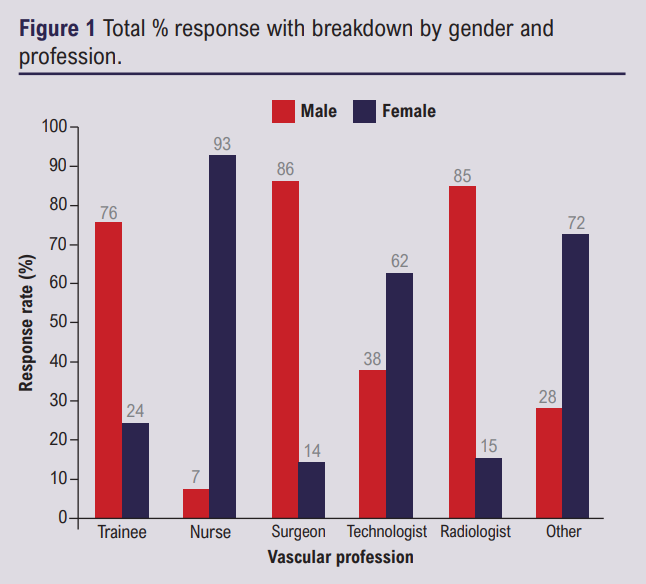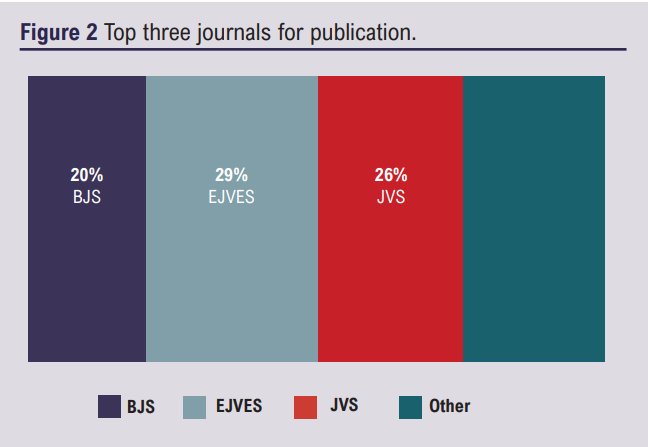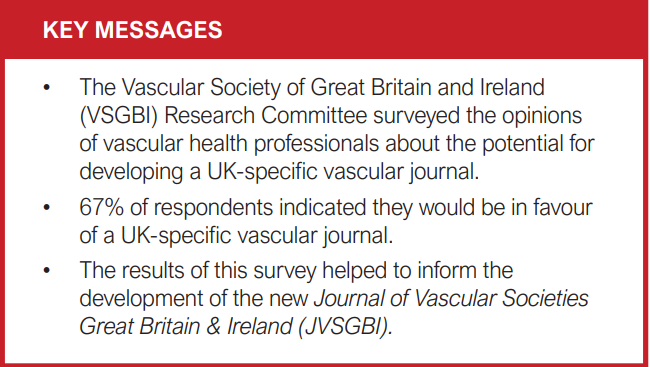ORIGINAL RESEARCH
Do we need a UK vascular journal? Survey of multidisciplinary UK vascular specialists
Long J,1 Lathan R,1 Sidapra M,1 Chetter I,1 Nandhra S on behalf of the VSGBI Research Committee2
Plain English Summary
Why we undertook the work: There are many vascular journals in circulation worldwide but none are dedicated to UK practice. This limits the opportunity for UK based vascular professionals to publish relevant research. A survey was developed to find out if UK based vascular healthcare professionals would support the development of a new UK-specific vascular journal.
What we did: In May 2020, an online questionnaire was sent out to different types of vascular health professionals including surgeons, nurses, technologists, trainees, physiotherapists and others, via email with links promoted on social media.
What we found: Responses were collated from 359 participants and the majority indicated they would be in favour of developing a UK-specific vascular journal. It was suggested that a new journal should be delivered online, four times per year and that the cost should be included in their society membership fees. Participants who thought a new journal was not needed suggested that instead it would be better to focus on improving links with existing journals. However, most participants welcomed the idea of a journal relevant to UK practice, in particular one that would include different types of vascular health and care professions and thereby encourage working together.
What this means: Overall, feedback collected from the survey was positive and suggested a demand for a UK-specific vascular journal. The results of this survey helped to inform the development of the Journal of Vascular Societies Great Britain & Ireland (JVSGBI).
Abstract
Background: Prior to the development of the Journal of Vascular Societies Great Britain & Ireland (JVSGBI), there were limited opportunities for UK based vascular health professionals to publish research relevant for UK vascular practice. A survey was developed to evaluate the appetite and potential infrastructure for a UK vascular journal amongst vascular healthcare professionals.
Methods: In May 2020, an online questionnaire was administered by The Vascular Society of Great Britain and Ireland (VSGBI) Research Committee, surveying vascular health professionals regarding the development of a UK-specific vascular journal. The survey was disseminated via email to multi-disciplinary members of the vascular community with links promoted on social media.
Results: Responses were received from 359 individuals identifying predominantly as surgeons (38%), nurses (8%), technologists (10%), radiologists (20%), trainees (10%), physiotherapists (7%) and other (7%). The majority of participants (67%) indicated they would be in favour of a UK-specific vascular journal and that it should be available as an online quarterly publication. Almost three quarters (74%) of respondents thought a subscription fee should be included in societies’ membership fees. Free text comments highlighted a few concerns, suggesting the focus should instead be to improve the quality of existing vascular journals. However, most respondents welcomed the idea of a journal relevant to UK practice, with inclusivity of all UK vascular professions to encourage more collaborative working.
Conclusions: Overall, feedback collected from the survey was positive and suggested a demand for a UK-specific vascular journal, providing an indication that the development of such a journal should be further explored. The results of this survey helped to inform the development of the JVSGBI.
Background
A number of vascular societies world-wide have an allied or specific vascular journal for the publication of work presented or conducted by their members. Now that UK vascular surgery is a speciality in its own right there are limited options for publication of UK vascular research, potentially compromising the opportunity of UK based vascular health professionals to share and disseminate their academic work.
Furthermore, the conglomeration of the Society of Vascular Nursing (SVN), Society of Vascular Technologists (SVT) and the Vascular Society of Great Britain and Ireland (VSGBI) each year at the annual scientific meeting (ASM) has led to the awareness of multi-disciplinary research relevant to day to day UK vascular practice with cross-pollination of ideas and research. The natural progression therefore is towards a UK vascular journal allied to UK vascular societies for the publication of work conducted by their membership. Prior to the development of the Journal of Vascular Societies Great Britain & Ireland, there was no dedicated UK vascular specific journal.
Aim
The aim of this survey was to establish whether there was potential authorship, readership and sufficient demand for a UK vascular journal.
Methods
Survey design
This article adheres to the reporting recommendations from the Consensus-Based Checklist for Reporting of Survey Studies (CROSS).1 The survey was devised by a sub-group of members from the Research Committee of the VSGBI. It was designed to obtain a high level overview of the opinions of vascular clinicians in the following areas; 1) to understand current levels of engagement with existing vascular journals, 2) to explore enthusiasm for developing a UK-specific vascular journal, 3) to gain feedback on format and content of a proposed new journal, 4) to capture contact details of those who would like to be involved in the development of a UK-specific vascular journal.
A pilot survey was undertaken and presented to the VSGBI research council on 6th February 2020. Following critique of the questionnaire, minor clarifications were made to wording of three questions, the option set was increased for demographic questions to widen the range of health or care professions, and additional choices suggested for the question about existing vascular journal titles. After corrections based on review by the VSGBI research council, an electronic survey, consisting of 17 questions, was generated using an online survey tool Qualtrics (Qualtrics, Provo, UT), see Appendix 1 (online at www.jvsgbi.com). This survey was circulated by email to clinicians involved in the care of vascular patients including members of the VSGBI, SVN, SVT, the Vascular and Endovascular Research Network (VERN), the Rouleaux Club (RC), the British Society of Interventional Radiology (BSIR) and the British Association of Chartered Physiotherapists in Amputee Rehabilitation (BACPAR). The survey opened on 12th May 2020 and remained open for 3 months until 13th August 2020. Direct emails and social media (twitter) were used to promote the survey.
The survey consisted of three main sections to cover demographics, current journal use and potential format and content of a new UK specific journal. Responses were designed to be either binary (Yes/No), or a selection of options from a pre-defined list. Where options were provided, instructions of select one or select as many as apply were clear. Where the option of ‘other’ was provided, space to give further detail was provided as a free text box. At the end of the survey, participants were invited to volunteer their contact information if they expressed an interest in being involved in the editorial committee or journal article reviewer.
Data management
Data management followed requirements of the General Data Protection Regulation (GDPR 2018). Access to data within Qualtrics was restricted to authorised survey administrators, who were Good Clinical Practice (GCP) trained. Data were securely downloaded into a password protected excel file. Any incomplete or blank data sessions were excluded from the analysis. Numerical data from the questionnaire were collated and presented in a descriptive manner. Qualitative responses to open questions were categorised into key themes and representative statements reported. Data were analysed by a lead data coordinator and verified by two senior colleagues.
Ethical approval was not required for this survey as participants were invited to volunteer their information, however approval from the VSGBI Research Committee was obtained prior to survey distribution.
Results
Demographics
Details of respondents’ age, gender, and profession were gathered. A total of 359 individuals submitted complete responses. Overall, 66% of respondents identified as male (n=237) and 34% female (n=122). The majority of responses were submitted by surgeons (38%) followed by radiologists (20%), trainees (10%), technologists (10%) and nurses (8%). The category of ‘other’ accounted for 14% of the overall response rate and included 25 responses from individuals that identified as physiotherapists. Figure 1 shows the total % response with breakdown by gender and profession.
Engagement with existing vascular journals
Almost 60% of respondents reported that they or their employer subscribed to a vascular journal and, of these, 57% reported this was an organisational subscription as opposed to a personal subscription. The survey asked participants to identify their top three journals for publication of research (Figure 2). Over 40 different journal titles were submitted in this section. The European Journal of Vascular and Endovascular Surgery, EJVES (29%), Journal of Vascular Surgery, JVS (26%), British Journal of Surgery, BJS (20%) were the most popular choice. If respondents were unsuccessful at their top three choice of journals for publication, the Annals of Vascular Surgery was rated as the next best option. CardioVascular and Interventional Radiology (CVIR) and Journal of Vascular and Interventional Radiology (JVIR) rated highly amongst BSIR members. Minor comments submitted by a few individuals at the end of this section suggest that aiming for a lower impact journal might also be an acceptable route to publication.
Potential for a UK-specific vascular journal
When participants were asked if they thought a UK vascular specific journal was required, 67% answered yes (Figure 3) and when participants were asked if they would consider submitting to a UK vascular journal first, 73% answered yes (Figure 4). This overall positive response was reflected across the breakdown of all vascular professions.
Format and content of a UK-specific vascular journal
Journal access
The next section of the survey asked respondents about their preferences for accessing a new journal. Over half of respondents (60%) indicated online access would be preferable compared to 37% that favoured a mixture of online and paper (only 3% indicated paper as a preference).Frequency
A quarterly publication was rated the most popular frequency to publish (66%), followed by monthly publication (26%) (Figure 5). Additional comments included suggestions that the publication could begin as a quarterly and then adjust frequency according to demand. Individuals who did not welcome the idea of a UK specific vascular journal left comments to re-emphasise they thought it unnecessary.
Sub-sections
When asked how the journal should feature sub-sections on vascular disease, 85% of respondents selected to format the journal by category of disease, compared to 10% who favoured arranging by vascular society. There were free text comments relating to advice or suggestions about the format of the journal with multiple references to inclusivity of all UK vascular professions that could be reflected in the journal title and layout. It was recommended that relevant sections for other clinical professionals such as physiotherapists, occupational therapy, nursing and podiatry should be included. Others also suggested including update sections for education and training as well as relevant opinion and news pieces.
Title
A suggested journal title of ‘UK Vascular Societies’ Journal (UKVSJ) was given to respondents to rate on a scale of 0-10 but it did not prove popular. Respondents submitted over 100 suggestions for alternative titles such as the Journal of Vascular Societies Great Britain & Ireland (JVSGBI), British Journal of Vascular Surgery (BJVS), Journal of UK Vascular Societies, Flow, Vascular UK Today and others.
Subscription
Just over half of respondents (51%) would not be willing to pay a subscription fee and 74% think a subscription fee should be included in societies’ membership fees. One respondent commented that a subscription fee could potentially act as a deterrent.
Editorial Committee
Respondents were asked if they would consider participating in the editorial committee or undertaking review of articles and reassuringly over half of respondents (54%) stated they would be willing and they identified from across the range of vascular professions.
Comments section
Free text comments were submitted throughout the survey and included positive feedback such as “excellent idea” and “long overdue”. Additionally it was suggested that a multi-professional journal, inclusive of all UK vascular professions, would encourage more collaborative working and promote more widespread evidence based care. There were also some negative comments such as “terrible idea” and “unnecessary”. A number of individuals highlighted concerns that there are already “too many journals” and that the introduction of another could result in “poor quality” and “low impact” publications. There was a perception from some individuals that there is already an abundance of vascular journals with a variety of impact factors and that instead of creating another journal, a focus could instead be to improve links with existing journals such as EJVES and BJS.
Limitations
Like most surveys, there is a potential issue around how representative the results are in reflecting the opinions of the UK vascular professions. The response rates are comparatively low to the numbers of vascular professionals registered with society memberships. However, when the data are categorised into those in favour of a new journal and those who find it unnecessary, there is general agreement across survey questions.
Conclusion
Overall, the findings from the survey suggest there is a demand for a UK-specific vascular journal. Respondents who are supportive of the idea suggest it could provide opportunities to foster multidisciplinary collaboration as well as intersociety and interspecialty relations, perhaps resulting in improved patient care. Comments suggest readers would find it beneficial to be aware of the latest developments and current UK practices amongst different vascular fields. The preferred format and content would be to have a quarterly publication online, organised by category of disease. There are additional suggestions for special issues or separate sections to focus on news, education and training items.
Those not in favour of having a UK-specific vascular journal submitted similar comments regarding existing journals and that perhaps a better solution was to strengthen links with these journals and to focus on improving the quality of published research. They also highlighted important considerations such as cost and the implications of the huge amount of work involved in starting a new journal.
The results of this survey subsequently helped to inform the development of the new Journal of Vascular Societies Great Britain & Ireland (JVSGBI).
Article DOI:
Journal Reference:
J.Vasc.Soc.G.B.Irel. 2021;1(1):6-10
Publication date:
November 24, 2021
Author Affiliations:
1.Academic Vascular Surgical Unit Vascular Labs, 1st Floor Tower Block, Hull Royal Infirmary, Anlaby Road, Hull, UK
2.The Newcastle upon Tyne Hospitals NHS Foundation Trust, Newcastle upon Tyne, UK

















